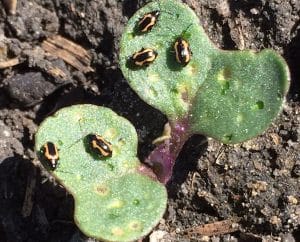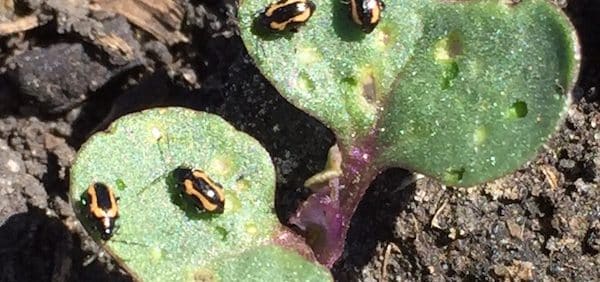Cool, windy, wet weather can delay flea beetle emergence. Peak emergence of the crucifer flea beetle occurs when ground temperatures reach 15°C, which is why perhaps it seems numbers are lower in many areas so far this year. They just haven’t come out in large numbers in some areas.
Even when they do come out, just seeing flea beetles is not a reason to spray. The action threshold for flea beetles in canola crops in Canada is an average leaf area loss of 25% or more. The economic thresholds – the point at which foliar insecticide provides an economic benefit – could be when damage reaches 50%. The reason for the action threshold is that leaf area loss can reach the 50% stage fairly quickly when flea beetle numbers are high, they are actively feeding, and damage is already at 25%. READ MORE
Clusters of flea beetles that cause threshold levels of damage in small areas is not necessarily a reason to spray. As with most pest and disease outbreaks, our eyes are naturally drawn to areas where beetles cluster and cause more damage. But thresholds are based on average levels of damage across the whole field, so good decisions are based on observations beyond headlands and clusters.
Alberta Agriculture entomologist Scott Meers says: “We assume insects are going to be like rain, spread evenly across the field. But that is seldom the truth.” Clusters occurs naturally for mating purposes and possibly to protect the population from predators.
One reason a specific area can have more flea beetles is the presence of canola volunteers. Because volunteers don’t have seed treatment and because they tend to emerge earlier than the crop, flea beetles tend to feed on them more successfully.
An image that needs interpretation:

Look at all the flea beetles on this tiny plant! Spray the field immediately!
But if this picture says 1,000 words, it would be 1,000 words of B.S. Justine had walked the whole field, and this was one of the few plants that had a mini-cluster of flea beetles. Overall numbers across the field were very low. The field did not need to be sprayed. Not even close.
Further reading:
Wind drives flea beetles to feed on stems
9 steps to make the right flea beetle spray decision
